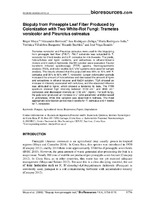Biopulp from pineapple leaf fiber produced by colonization with two white-rot fungi: Trametes versicolor and Pleurotus ostreatus

Fecha
2016Autor
Rodríguez-Zúñiga, Ana
Rodriguez-Solis, María
Villalobos-Barquero, Verónica
Vega-Baudrit, José
Moya-Roque, Róger
Berrocal-Jiménez, Alexander
Starbird-Pérez, Ricardo
Metadatos
Mostrar el registro completo del ítemResumen
Trametes versicolor and Pleurotus ostreatus were used for the biopulping from pineapple leaf fiber (PALF). PALF substrate was subjected to T. versicolor for 2 to 6 weeks and to P. ostreatus for 4 to 8 weeks. The yields, holocellulose and lignin contents, and extractives in ethanol-toluene mixture and in sodium hydroxide (NaOH) solution were evaluated. Fourier transform infrared spectroscopy (FTIR) spectra, thermogravimetric analysis (TGA), and color studies by L*a*b* systems were used for sample analysis. The results showed that the pulp yield was 55% to 70% with P. ostreatus and 35% to 50% with T. versicolor. Longer colonization periods increased the amount of holocellulose and decreased the amount of lignin and extractives in ethanol-toluene and NaOH solution. TGA showed an increase in intensity associated with cellulose, and the observed inflexion was attributed to lignin, which showed a tendency to fade. The FTIR spectrum showed high intensity between 3100 cm-1 and 3600 cm-1 (cellulose) and decreased intensity at 1730 cm-1 (lignin). For both fungi, the pulp color produced an increase in L* color parameter and decreased in yellowness, while little variation was observed in redness. The most appropriate colonization period was 5 weeks for P. ostreatus and 4 weeks for T. versicolor.
Descripción
Artículo científico
Fuente
BioResourcesCompartir
Métricas
Colecciones
- Artículos [37]

